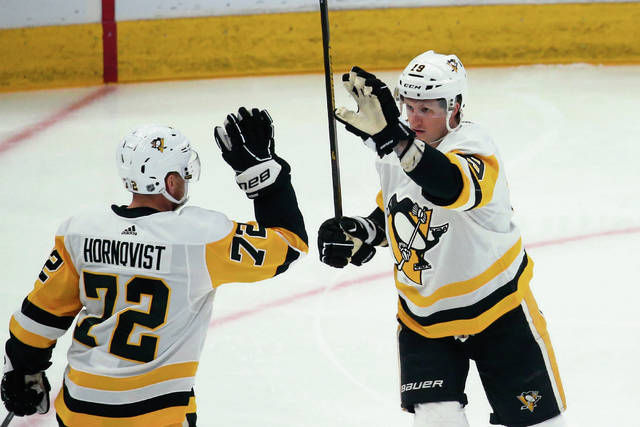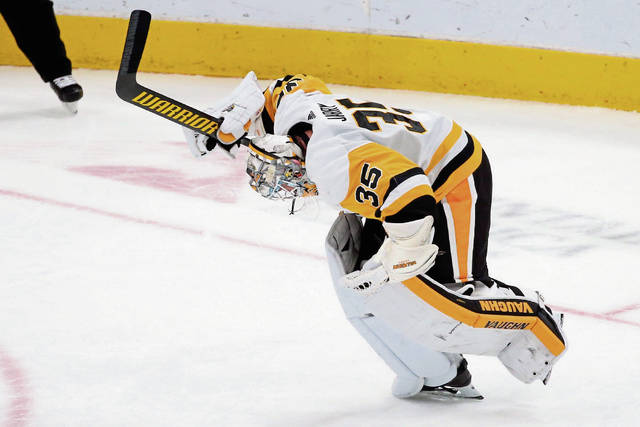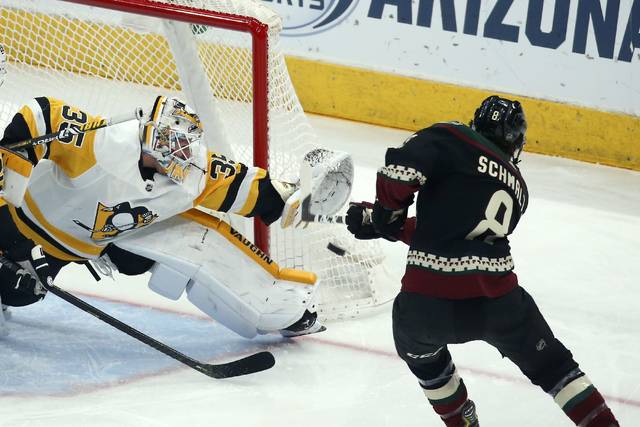Penguins get 2 power-play goals, outlast Coyotes in 8-round shootout
GLENDALE, Ariz. — The Pittsburgh Penguins were hopeful they would see captain Sidney Crosby back in the lineup Sunday at Gila River Arena.
Alas, it was not to be. The superstar forward missed his 28th consecutive game because of a core muscle ailment.
As a consolation, they had a different type of return, one that involved a dangerous power play.
The Penguins were 2 for 4 on the power play and defeated the Coyotes, 4-3, in a shootout.
That success with the man advantage marked a stark contrast to how the Penguins have performed on the power play most of the season. Entering Sunday’s game, they were 21st in the NHL with a conversion rate of only 17.9%.
A simpler approach allowed the Penguins to convert a five-on-three advantage in the first period as well as a conventional five-on-four sequence in the second.
“We’ve been preaching that all year long with our power play,” coach Mike Sullivan said. “But I think it was just about making good decisions and execution. The five-on-three was really good. That’s something that we’ve worked on a fair amount. They were sharp. They made good decisions with the puck, and they executed.
“The five-on-four goal was the same thing. We were sharper. We made better decisions. As a result, we gave ourselves some pretty good looks.”
Despite so many injuries, the Penguins have been relatively consistent through every area of the game.
That could describe the power play as well, considering it has been tepid regardless if Crosby or other power-play contributors such as Jake Guentzel or Justin Schultz are able-bodied.
The Penguins appeared to be apt pupils Sunday as they scored multiple power-play goals in the same game for only the fifth time this season.
Only 2 minutes, 43 seconds into regulation, the Penguins claimed a 1-0 lead with that five-on-three power-play score by forward Jared McCann, who netted his 13th goal of the season, against goaltender Adin Hill.
The Coyotes tied the score 1-1 at 14:23 of the first period thanks to forward Conor Garland’s 15th goal on goaltender Tristan Jarry.
Their second power-play goal 3:51 into the second period restored a lead for the Penguins, 2-1.
Off a feed from forward Evgeni Malkin, forward Patric Hornqvist scored his 11th goal.
Arizona tied the score again at 9:51 of the second when forward Taylor Hall scored his 10th from the left circle.
At 11:28 of the third, the Coyotes took their first lead at 3-2, when forward Derek Stepan swatted a one-timer from above the crease.
At at 16:58 of the third, Penguins forward Brandon Tanev collected his 10th goal to forge a 3-3 deadlock.
Goals by forward Bryan Rust and forward Teddy Blueger in an eight-round shootout gave the Penguins the victory. Blueger’s goal, which was the winner, was a rarity for him.
“The last time I was in the shootout, I maybe had one or two tries, last year in Wilkes-Barre early on in the year,” Blueger said. “It’s not something I’m used to for sure.”
The Penguins wouldn’t mind getting used to having a potent power play once again regardless, especially once Crosby returns.
“Power plays, I think they’re one of the more challenging things to coach because sometimes as coaches, when you’re coaching offense, there’s always a fine line between overcoaching and players becoming robotic (or) undercoaching in the sense that you don’t give them enough structure so that they can be somewhat predictable for one another,” Sullivan said. “We’ve always, as a coaching staff, tried to find that sweet spot where we try to give them a sound foundation and some structure.
“But we also give them some latitude because we believe in that. We want to give them latitude to act on their instincts and to go off the grid a little bit.”
Seth Rorabaugh is a TribLive reporter covering the Pittsburgh Penguins. A North Huntingdon native, he joined the Trib in 2019 and has covered the Penguins since 2007. He can be reached at srorabaugh@triblive.com.
Remove the ads from your TribLIVE reading experience but still support the journalists who create the content with TribLIVE Ad-Free.



